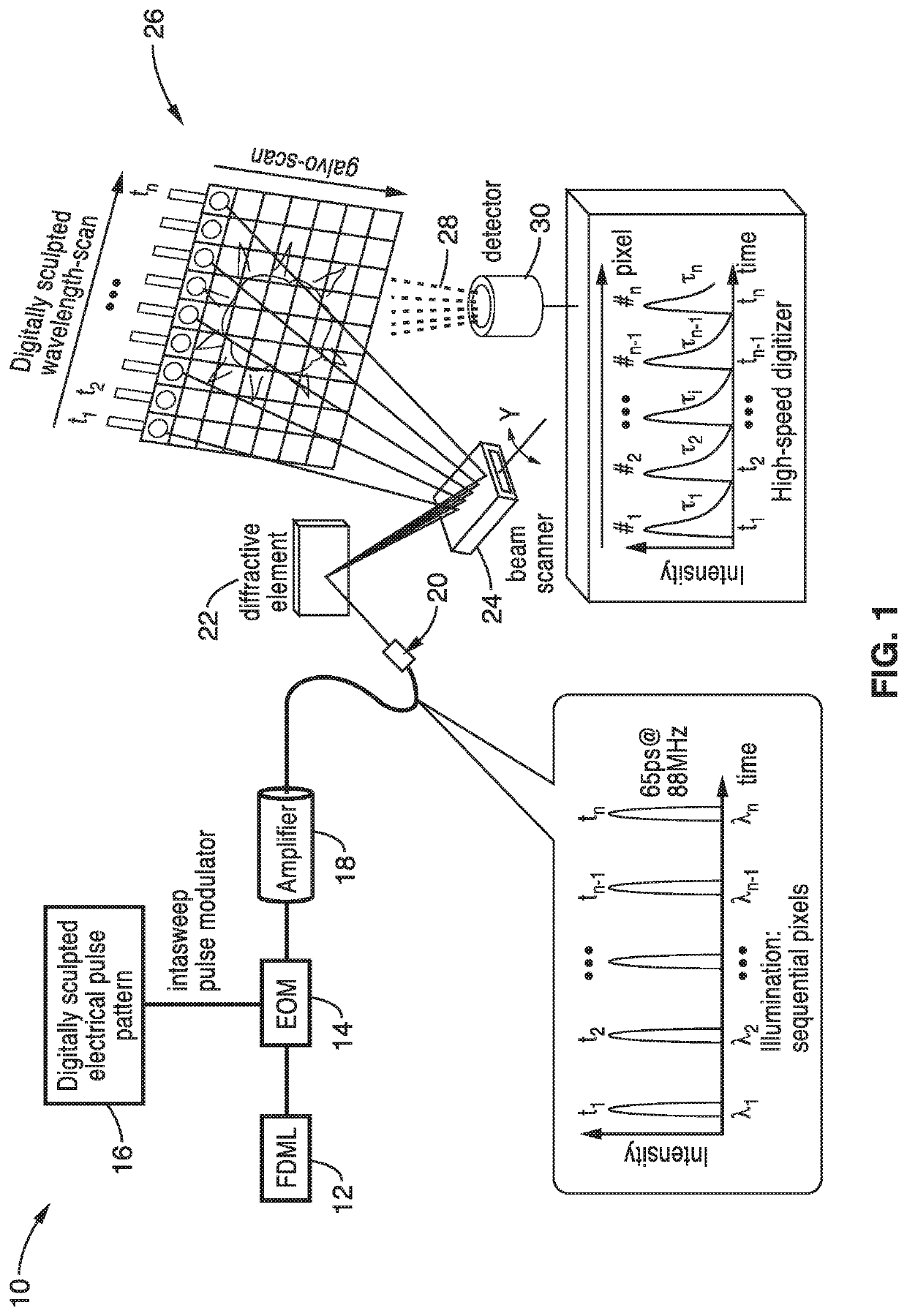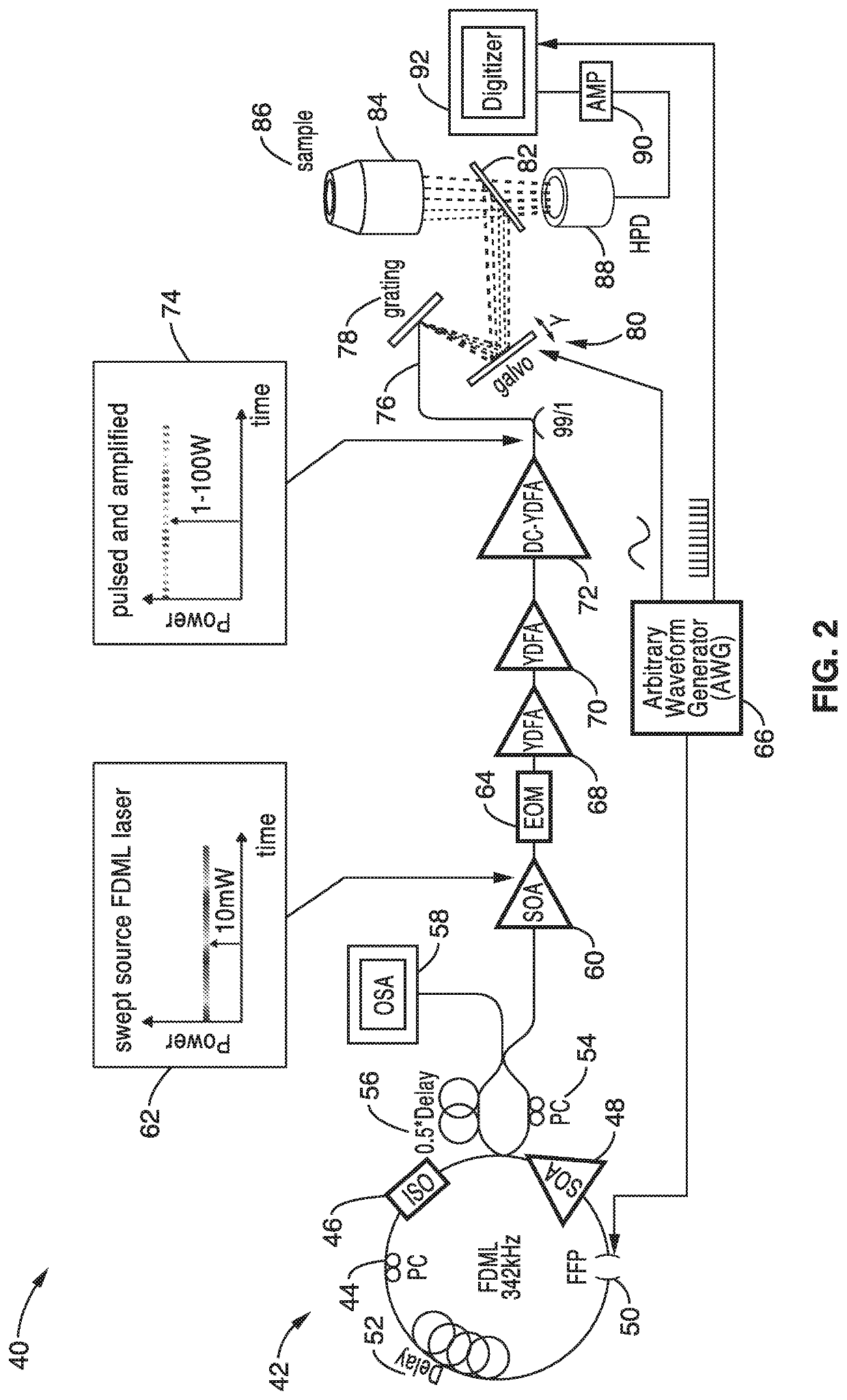Fast two-photon imaging by diffracted swept-laser excitation
a technology of diffracted laser excitation and two-photon fluorescence, which is applied in the direction of fluorescence/phosphorescence, spectroscopy, active medium materials, etc., can solve the problems of limiting frame rate, reducing nonlinear vs. linear process efficiency, and achieving high speed, so as to achieve fast nonlinear imaging speed and lifetime imaging capability , the effect of increasing the number of photons
- Summary
- Abstract
- Description
- Claims
- Application Information
AI Technical Summary
Benefits of technology
Problems solved by technology
Method used
Image
Examples
example 1
[0056]In order to demonstrate the operational principles of the apparatus and the capture and identification methods, a testing apparatus embodiment was fabricated with a structure and processing steps shown generally in FIG. 2 and tested.
[0057]The setup of the Spectro-temporal Lifetime Imaging by digitally sculpted excitation (SLIDE) system embodiment 40 shown if FIG. 2 has a light source 42 with a wavelength swept FDML laser at 1060 nm (±6 nm) and 342 kHz sweep repetition rate. The light source 42 in this embodiment has a PC: Polarization Controller 44, an ISO: Isolator 46, a SOA: semiconductor optical amplifier 48 a FFP: Fiber Fabry-Pérot Filter 50, and a delay 52. The light source output 62 also has a PC: Polarization Controller 54, a delay 56 and an OSA: optical spectrum analyzer 60. The wavelength sweep is accomplished by the fibre Fabry-Pérot-Filter (Lambdaquest) 50 driven at 171 kHz. The FDML output is two-times buffered to 342 kHz sweep rate. After the buffer stage, a boost...
example 2
[0067]For cell classification and detection of rare cells, such as circulating tumour and fetal cells, it is important to measure a high number of cells quickly, accurately and as non-invasively as possible. Two-photon microscopy has high three dimensional resolution, can operate in blood flow and offers deeper penetration than one-photon techniques through the use of longer wavelengths. Two photon imaging in flow may also be used for non-invasive in vivo cancer cell detection through the skin barrier.
[0068]To further illustrate the capabilities of the system, Two-Photon Fluorescence Lifetime Imaging (2P-FLIM) based flow cytometry at an 88 MHz pixel rate was demonstrated. The particles were fluorescent beads used in blood flow determination studies with diameters in the range 2 μm to 15 μm, similar to typical cell sizes. The flow-rate was set to 0.2 m / s, limited by diffraction spot size and fluorescent lifetime.
[0069]In the flow cytometry recordings, the flow-rate was set by two fun...
example 3
[0072]To further demonstrate the capabilities of the system, high speed two photon fluorescent images and fluorescent lifetime images of pollen and algae cells were obtained and evaluated. Fluorescent imaging can be used for classifications of algae cells used in biofuels based on their lipid content. Euglena gracilis algae cells with rich lipid content were stained with Nile Red. The cell's chloroplasts provide endogenous autofluorescence and the difference in fluorescent lifetimes clearly highlight the different sub-cellular features. These images were unaveraged and acquired within 497 μs for both TPEF and 2P-FLIM images that were acquired simultaneously. The lifetimes were extracted by de-convolving with the instrument's response function.
[0073]For precise measurement, a deconvolution with the IRF was conducted in order to extract the fluorescent lifetimes. However, this was time consuming, so for faster processing and qualitative results a tail-fitting algorithm was used. In so...
PUM
| Property | Measurement | Unit |
|---|---|---|
| fluorescent decay time | aaaaa | aaaaa |
| time | aaaaa | aaaaa |
| diameter | aaaaa | aaaaa |
Abstract
Description
Claims
Application Information
 Login to View More
Login to View More - R&D
- Intellectual Property
- Life Sciences
- Materials
- Tech Scout
- Unparalleled Data Quality
- Higher Quality Content
- 60% Fewer Hallucinations
Browse by: Latest US Patents, China's latest patents, Technical Efficacy Thesaurus, Application Domain, Technology Topic, Popular Technical Reports.
© 2025 PatSnap. All rights reserved.Legal|Privacy policy|Modern Slavery Act Transparency Statement|Sitemap|About US| Contact US: help@patsnap.com


